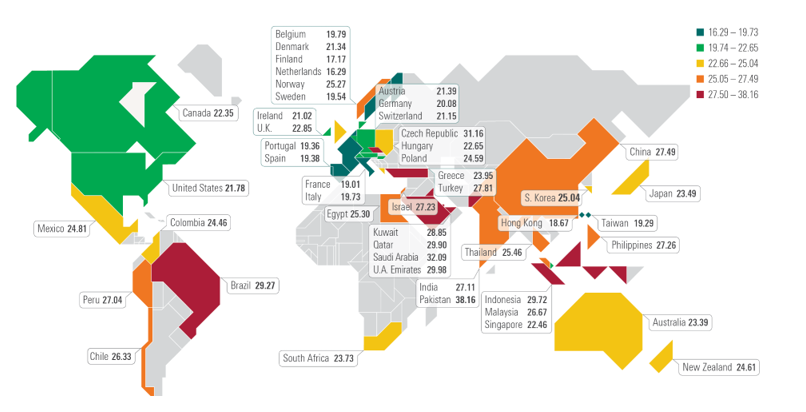En nuestra sección para profesionales hemos querido reproducir (en inglés) una entrevista que hicimos a Matthew Gries, Director de desarrollo de nuevos productos de Morningstar Indexes, sobre los nuevos índices de sostenibilidad de Morningstar.
Why is Morningstar launching a Sustainability Index family now?
Matt: We found that there’s a need in the market for more investable benchmarks to serve as the foundation for ESG products. We see a need in the market for more ESG building blocks that allow investors to construct a robust strategic asset allocation. There’s also great potential to marry ESG with different investment factors like dividends or value. There’s no reason that ESG investors shouldn’t be able to also access sources of investment return in a low-cost, low-turnover, transparent, and systematic format.
How did Morningstar choose an approach to building a sustainable index family?
Matt: I think we recognize that investors often have a fairly specific asset allocation strategy in place. And it’s probably in place because they’re trying to achieve something, so they can’t really afford to deviate from that. A benchmark that delivers a radically different risk/return profile just isn’t realistic for them. Our Indexes team is able to draw on Morningstar’s experience serving more than a million individual investors and over 250,000 advisors. So we had a pretty good sense of what kind of performance and risk profile investors are seeking when we built the base Sustainability Indexes family. Meanwhile, we work closely with asset managers to build indexes used for investable products. So over the years, we’ve developed a sense of what constitutes reliable building blocks for product creation.

How are these indexes constructed? Is there a difference between the Morningstar Sustainability Rating and the indexes?
Matt: Our process begins with accessing Morningstar’s universe of fundamental research. We have a deep equity research bench—we cover 1,500 companies with 100 analysts worldwide. And Sustainalytics, like us, considers both qualitative and quantitative inputs in the security-level research we get from them. They assess 60-80 environmental, social, and governance indicators, producing a series of scores that Morningstar uses for ratings and for indexes. The research Sustainalytics ofers was a great foundation for us on the index side. So our indexes are very much aligned with the Morningstar Sustainability Rating.
The company ESG score is the aggregate of all the factors that Sustainalytics examines and is scored between 0 and 100. There’s also a deduction for controversial incidents—things like ethics violations or environmental problems. We select the highest-scoring companies in each industry, sector and region until we reach 50% of market capitalization. We also limit deviation from the market benchmark weightings at the sector and regional level. For example, our sustainability indexes will not exhibit a large underweighting to utilities, or overweighting in Europe relative to a non-ESG counterpart. When we design benchmarks, we adhere to best practices of index construction. Our indexes are largely refective of an investor’s complete opportunity set in the market or market segment they’re designed to represent. They are powered by accurate and complete data, have clearly published rules, and exhibit low turnover and transaction costs.

Can you talk more about the ESG selection process for the index?
Matt: An example is probably the best way to tell the story. If you consider the U.S. technology sector, Microsoft makes it into our ESG index family, while Apple is excluded right now. Microsoft scores well relative to other software companies, especially on the environmental and governance factors. Microsoft is a leader when it comes to reducing its carbon footprint. It takes data privacy and security seriously. Its board of directors is strong. Apple, by contrast, tallies average scores on environmental and governance factors and is an underperformer on the social side. The issues relate to how Apple deals with some of its labor and supply chain issues.
How does the Controversy Score impact index membership?
Matt: The controversy component is important because it gauges a company’s actions and not just its words. Simply put, companies experiencing serious controversies at the time that index membership is reset are not included. Two recent examples from 2016 would be Target and Johnson & Johnson— Target due to legal and reputational fallout from its customer data breach and J&J as a result of serious product safety-related incidents.
Does intentionality matter? In other words, how does intentionality affect the inclusion of industries in the index?
Matt: We think this is something that the financial services industry struggles with. As an index provider, do we exclude certain companies categorically? Do we confine ourselves to companies that have already absorbed and implemented sustainability in their business models? Or should standards be applied more broadly? We are taking a best-in-class approach for our broad ESG benchmark series. A company might be in the oil business, with all the accompanying environmental stresses, but if it’s got a better score than all the other oil companies, it will find its way into the index. We did ask ourselves a question about the nature of certain products, though: If used as directed, is the impact inherently harmful? So we didn’t screen out alcohol. Used as directed, alcohol doesn’t kill. But when it came to certain other products, we decided to leave them out of the index. So you simply won’t find manufacturers of cluster munitions or biological weapons.







:quality(80)/cloudfront-us-east-1.images.arcpublishing.com/morningstar/NNGJ3G4COBBN5NSKSKMWOVYSMA.png)

.jpg)

















